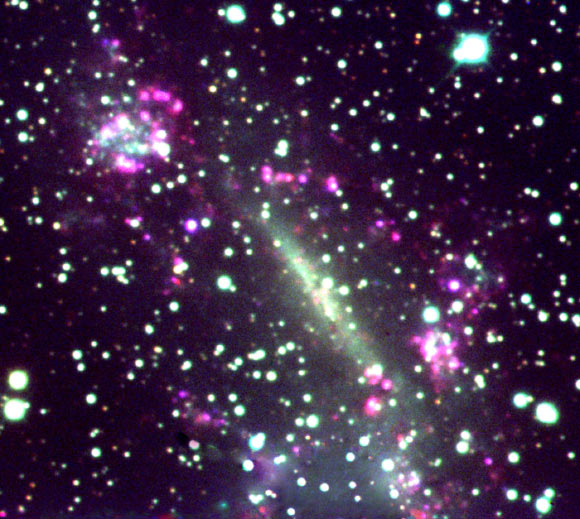An international team of astronomers announced yesterday the discovery of the closest collisional ring galaxy to our Milky Way.

This image shows a collisional ring galaxy called the Kathryn’s Wheel. The image measures approximately 4 arcminutes across, and was taken by the Cerro-Tololo InterAmerican Observatory 4-m telescope in Chile. Image credit: Ivan Bojicic / Quentin A. Parker et al.
The newly-discovered galaxy, dubbed Kathryn’s Wheel, is located in the constellation Ara. It is approximately 30 million light-years away, which means that it is relatively close by.
Such objects are extremely rare – fewer than 20 systems with complete rings are known. They arise from ‘bulls-eye’ collisions between two galaxies of similar mass.
Shockwaves from the collision compress reservoirs of gas in each galaxy and trigger the formation of new stars. This creates a spectacular ring of intense emission, and lights up the system like a Catherine wheel firework on bonfire night.
The Kathryn’s Wheel has a physical size of 49,000 light-years. The main galaxy shows a full ring of star-forming knots, 20,000 light-years in diameter surrounding a quiescent disc. The smaller assumed ‘bullet’ galaxy also shows vigorous star formation.
“Not only is this system visually stunning, but it’s close enough to be an ideal target for detailed study,” said Prof Quentin Parker from the University of Hong-Kong, lead author on the study published in the Monthly Notices of the Royal Astronomical Society.
“The ring is also quite low in mass – a few thousand million suns, or less than 1 percent of the Milky Way – so our discovery shows that collision rings can form around much smaller galaxies than we thought.”
The system was discovered during a special survey of the Southern Milky Way undertaken with the UK Schmidt Telescope in Australia.
It is 7 times closer than anything similar found before, and 40 times closer than the famous Cartwheel Galaxy.
It is located behind a dense star field and close to a very bright foreground star, which is why it had not been noted before. There are very few other galaxies in its neighbourhood; the odds of a collision in such an empty region of space are very low.
Smaller galaxies are more common than large ones, implying that collisional rings could be 10 times as common as previously thought. Prof Parker and his colleagues intend to carry out more detailed studies on larger telescopes since the Kathryn’s Wheel is currently the only one of its kind close enough to permit study in such exquisite detail.
_____
Quentin A. Parker et al. 2015. Kathryn’s Wheel: a spectacular galaxy collision discovered in the Galactic neighbourhood. MNRAS 452 (4): 3759-3775; doi: 10.1093/mnras/stv1432







